As required by Section 18 of the OCS Lands Act, the National Outer Continental Shelf (OCS) Oil and Gas Leasing Program (National OCS Program) consists of a schedule of lease sales indicating the size, timing, and location of proposed leasing activities on the OCS that the Secretary of the Interior determines will best meet national energy needs for the five-year period following the approval of a new National OCS Program. BOEM is tasked with developing the National OCS Program, advising the Secretary, and administering the program once it is adopted.
- New Program Development
- 2024–2029 Program
- Sale Schedule
- Requirements & Factors
- FAQs
- Learn More
- Past Programs
What’s New?
On April 18, 2025, the Department of the Interior announced the first step in a robust public engagement process to develop a proposed schedule for offshore oil and gas lease sales on the U.S. Outer Continental Shelf (OCS).
The Request for Information (RFI) for the 11th National Oil and Gas Leasing Program will be published in the Federal Register in the near future. Publication will open a 45-day public comment period and serve as the initial step in a multi-year planning process.
The Department also announced that BOEM’s jurisdiction on the OCS has recently changed. A new planning area offshore Alaska - the High Arctic - is being established as the 27th OCS planning area.
Additionally, boundaries of other existing planning areas are being updated to align with BOEM’s revised jurisdiction. Details on these changes will be published in the Federal Register and posted to BOEM’s website in the coming days.
Program Development
Under Section 18 of the Outer Continental Shelf (OCS) Lands Act, the Secretary of the Interior is responsible for approving a schedule of OCS oil and gas lease sales for a 5-year period. The approved schedule is called the National OCS Oil and Gas Leasing Program (National OCS Program). BOEM is responsible for developing the National OCS Program, advising the Secretary, and administering the National OCS Program once adopted.
- Only the lease sale areas and subarea options the Secretary decides are appropriate for further analysis are included in the analysis.
- Winnowing of available lease areas typically occurs during each of the analytical phases.
- Specific OCS Lands Act Section 18 requirements and factors are evaluated to determine which areas to include in a potential lease sale schedule. (See Requirements & Factors tab)
- These requirements include the size, timing, and location of proposed lease sales to best meet national energy needs.
National OCS Program Development Process
Request for Information and Comment (RFI)
- Requests information and comment from all stakeholders regarding all 27 planning areas
45-day Comment Period
Draft Proposed Program (DPP)
- The DPP document, which analyzes all 27 OCS planning areas, is published
- The Secretary presents their Draft Proposal, which could narrow the program areas that will remain under leasing consideration
60-day Comment Period
Proposed Program
- The Proposed Program document, which analyses the Draft Proposal, is published
- The Secretary presents their Second Proposal, which could narrow the program areas further
45-day Comment Period
Proposed Final Program (PFP)
- The PFP document, which analyzes the Second Proposal, is published
- The Secretary presents their Final Proposal
60-day Waiting Period for the President and Congress
Approval
- New National OCS Program is approved by the Secretary and a decision memo is posted
After National OCS Program Approval
A lease sale must be included in an approved National OCS Program to be held. A lease sale cannot be added to an approved National OCS Program without an act of Congress. Whether a lease sale is held depends on sale-specific analysis. Once a sale is held, BOEM performs a 90-day review and accepts or rejects lease sale bids.
A lease conveys the rights to explore for, develop, and produce the oil and gas contained within the lease area. The lease is a contractual agreement and defines requirements for surety bonds, royalty payments, rental payments, and assignment or other transfers. Once granted, an oil and gas lease gives the lessee a primary lease term to explore for and develop oil and gas resources. Primary terms range from 5 to 10 years, depending on water depth. A lessee must relinquish the lease if no activity has occurred within that specified amount of time.
All exploration, development, and production plans are carefully reviewed by BOEM. Once lessees receive plan approval from BOEM, the Bureau of Safety and Environmental Enforcement (BSEE) then exercises primary oversight of all permitting and operational activities (e.g., drilling and production). The pre- and post-lease processes are shown in the figure below.

On September 29, 2023, the Proposed Final Program (PFP) was published. The PFP covers the 5-year period starting on July 1, 2024, and continues through June 30, 2029. The PFP schedules three potential oil and gas lease sales in the Gulf of America (GOA) Program Area. Sixty days after the transmittal of the PFP to the President and Congress, the Secretary approved the 2024–2029 Program via a combined decision memo and Record of Decision. The three GOA sales are scheduled to occur over the 5 years of the 2024–2029 Program, with one sale each in 2025, 2027, and 2029. The Secretary retains discretion at the lease sale stage to determine whether, when, and under what terms a lease sale should be held and the precise acreage to be offered.
Supporting Documents
- Record of Decision (ROD)
- 2024–2029 Proposed Final Program Document
- Final Programmatic EIS
Supplemental Information
- Economic Analysis Methodology for the 2024–2029 National OCS Program
- Oil and Gas Economic Modeling Documentation
- GIS files for the 2024–2029 Proposed Final Program
The process of developing the 2024–2029 Program is described in the table below.
2024–2029 National OCS Program Development Full Process and Documents
| Phase | Official Notice | National OCS Program Document | Programmatic Environmental Impact Statement (EIS) | Economic Analysis Methodology Paper | Comment Period Dates | Comment Docket |
|---|---|---|---|---|---|---|
| Request for Information (RFI) | Federal Register Notice July 3, 2017 | July 3, 2017 – August 17, 2017 | BOEM-2017-0050 | |||
| Draft Proposed Program (DPP) and NOI to Prepare a Programmatic EIS | Federal Register Notice of Availability January 8, 2018 | 2019–2024 DPP (includes the Secretary’s Draft Proposal) | January 8, 2018 – March 9, 2018 | BOEM-2017-0074 | ||
| Proposed Program and Draft Programmatic EIS | Federal Register Notice of Availability July 8, 2022 | 2023–2028 Proposed Program (includes the Secretary’s Second Proposal) | Draft Programmatic EIS: Volume I Volume II | Draft Economic Analysis Methodology for the 2023–2028 National OCS Program | July 8, 2022 – October 6, 2022 | BOEM-2022-0031 |
| PFP and Final Programmatic EIS | Federal Register Notice of Availability October 2, 2023 | 2024–2029 PFP (includes the Secretary’s Final Proposal) | Final Programmatic EIS: Volume I Volume II | Economic Analysis Methodology for the 2024-2029 National OCS Program | ||
| 60-day Waiting Period | ||||||
| Decision Memo and Record of Decision | Program Approval and Record of Decision December 14, 2023 | |||||
Sale Schedule
After considering Outer Continental Shelf Lands Act Section 18 requirements and factors (See Requirements & Factors Tab), as well as input from governors and the public, the Secretary of the Interior decided to include three potential lease sales in the Gulf of America (GOA) Program Area in the 2024–2029 Proposed Final Program (PFP). Sixty days after the transmittal of the PFP to the President and Congress, the Secretary approved the 2024–2029 Program. The PFP covers the 5-year period starting on July 1, 2024, and continues through June 30, 2029. The GOA Program Area is composed of the Western GOA Planning Area and the portions of the Central and Eastern GOA planning areas not currently under Presidential withdrawal.
2024–2029 Proposed Final Program Lease Sale Schedule
| Count | Sale Number | Sale Year | OCS Region and Program Area |
|---|---|---|---|
| 1 | 262 | 2025 | Gulf of America: GOA Program Area |
| 2 | 263 | 2027 | Gulf of America: GOA Program Area |
| 3 | 264 | 2029 | Gulf of America: GOA Program Area |

Additional information about the lease sale planning process:
- Oil and Gas Lease Sales
- 2024-2029 GOA Area Identification
- 2024-2029 GOA Call for Information and Nominations
- Gulf of America Oil and Gas Programmatic EIS
Requirements & Factors
Section 18 of the Outer Continental Shelf (OCS) Lands Act authorizes the Secretary of the Interior to establish a schedule of lease sales for a five-year period by balancing specific factors of OCS regions and selecting the size, timing, and location of OCS lease sales that best meet regional and national energy needs and consider the impact of oil and gas exploration on the marine, coastal, and human environments.
When determining the schedule of lease sales, the OCS Lands Act requires the Secretary to consider the following four requirements and eight factors:
Section 18(a)(1): Economic, social, and environmental values
Section 18(a)(2): Factors for determining size, timing, and location of leasing
- Equitable sharing of developmental benefits and environmental risks among the regions;
- Existing information on geographical, geological, and ecological characteristics of regions;
- Location of regions with respect to, and the relative needs of, regional and national energy markets;
- Location of regions with respect to other uses of the sea and seabed, including fisheries, navigation, existing or proposed sea-lanes, potential sites of deepwater ports, and other anticipated uses of the resources and space of the OCS;
- Expressed interest of potential oil and gas producers in the development of oil and gas resources;
- Laws, goals, and policies of affected states, identified by Governors as relevant matters for the Secretary’s consideration;
- Relative environmental sensitivity and marine productivity of different OCS areas; and
- Relevant environmental and predictive information for different OCS areas.
Section 18(a)(3): Balancing the potential for environmental damage, discovery of oil and gas, and adverse impact on the coastal zone
Section 18(a)(4): Assure receipt of fair market value for the lands leased and the rights conveyed
The 2024–2029 Proposed Final Program document and Final Programmatic Environmental Impact Statement present the latest analysis of these requirements and factors (See 2024–2029 Program Tab).
Frequently Asked Questions
1. What does the Bureau of Ocean Energy Management (BOEM) do?
BOEM is the agency in the Department of the Interior that oversees science-informed management of oil and gas, renewable energy, and mineral resources on the Outer Continental Shelf (OCS). BOEM manages thousands of oil and gas leases covering millions of acres on the OCS, the vast majority of which are in the Gulf of America. For the most recent leasing stats, please check this page https://www.boem.gov/oil-gas-energy/leasing/outer-continental-shelf-lease-sale-statistics
2. What is the National Outer Continental Shelf Oil and Gas Leasing Program (National OCS Program)?
The National OCS Program consists of a schedule of oil and gas lease sales indicating the size, timing, and location of proposed leasing activity that the Secretary of the Interior determines will best meet national energy needs for a five-year period following a new National OCS Program approval and effective date.
3. DOI (BOEM & the Bureau of Safety and Environmental Enforcement) has an extensive regulatory and inspection program; can you describe this a bit more?
After obtaining a lease, a company must file an exploration plan before drilling any wells, and that plan is subject to a technical and environmental review by BOEM and regulatory supervision by BSEE. Once an oil and gas resource discovery is made that the company is interested in developing, it must file a development and production plan for BOEM to again conduct a technical and environmental review before production can begin. For major facilities, BSEE conducts an onsite inspection before allowing production to begin. Often this is a joint inspection with the U.S. Coast Guard. Air emissions permits and water discharge permits must also be obtained as required by law. BSEE has inspectors that fly daily offshore to conduct safety and environmental inspections.
4. What is the lifetime of a typical OCS Oil and Gas lease?
The timeline of an oil and gas lease can vary depending on whether hydrocarbons are found on the lease. By statute, a lease is granted for a primary term of 5 years, unless BOEM determines that the lease is in unusually deep water or involves other unusually adverse conditions, in which case the maximum primary term is 10 years.
The primary term is specified in the Notice of Sale prior to a lease sale and is included in the lease itself. To maintain a lease beyond the primary term, lessees must be undertaking operations with the objective of establishing production or demonstrating production of oil and gas in paying quantities.
Once a lease enters production, it is considered held by production, and the lessee may retain the lease as long as it continues producing in paying quantities and other lease requirements are met. If a lease enters production, it can produce for 40-70 years, depending on its location and conditions.
5. If Congress or the President disapprove of the National OCS Program, what can they do about it?
The President and Congress can enact new legislation, or the President can withdraw areas of the OCS from consideration for leasing using the authority in Section 12(a) of the OCS Lands Act. In either case, this could alter the scope of USDOI’s future offshore leasing activities.
6. Where can I find the history of lease sales in each National OCS Program?
The first National OCS Program took effect in 1980 and covered the years 1980-1985. Any sales prior to 1980 were done on a sale-by-sale basis. (See Past Programs Tab)
| Program# | Effective Date | Number of Sales* |
| 1st | 1980 - 1985 | 36 |
| 2nd | 1982 - 1987 | 41 |
| 3rd | 1987 - 1992 | 37 |
| 4th | 1992 - 1997 | 18 |
| 5th | 1997 - 2002 | 16 |
| 6th | 2002 - 2007 | 20 |
| 7th | 2007 - 2012 | 21 |
| 8th | 2012 - 2017 | 11 |
| 9th | 2017 - 2022 | 11 |
| 10th | 2024 - 2029 | 3 |
Chapter 4 of the 2024-2029 Proposed Final Program document discusses leasing background, history and status for all OCS regions and includes summary maps and charts.
*Please note that the number of sales shown is the maximum number of potential sales authorized for a given National OCS Program. All sales included in a National OCS Program may not have been held.
Oil & Gas Resource Assessment and Economic Considerations
Information about how the National Oil & Gas Geologic Resource Assessment is conducted to find potential oil and gas, and how it informs National OCS Program decisions. These materials provide information about the economic analysis conducted to inform National OCS Program decisions, and what economic factors are considered in evaluating a program area.

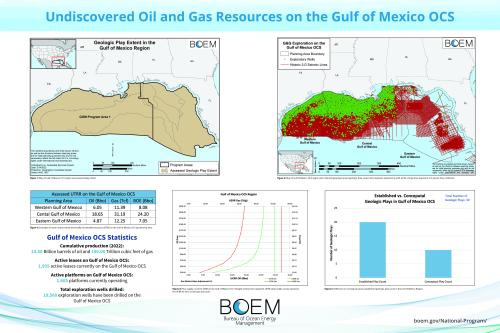
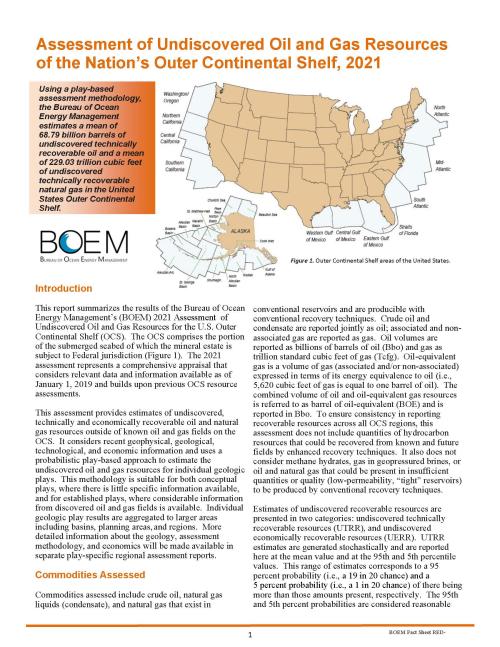


Environmental Considerations
The Programmatic EIS is prepared following the process prescribed by the National Environmental Policy Act (NEPA) and in accordance with the April 2022 revised NEPA regulations. The Programmatic EIS includes an analysis of the proposed action, alternatives, and cumulative and cross-boundary impacts.
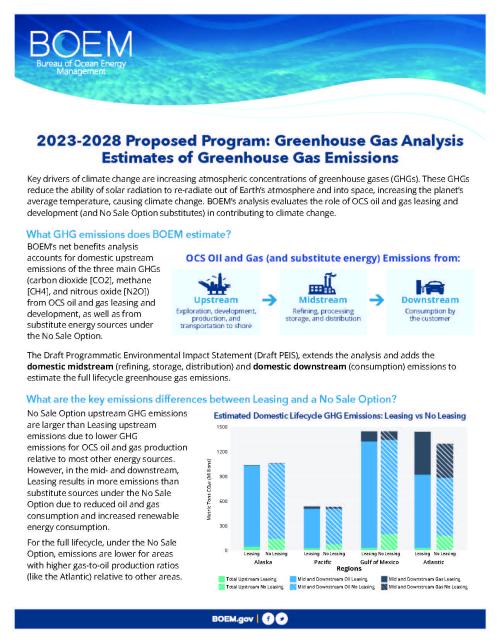
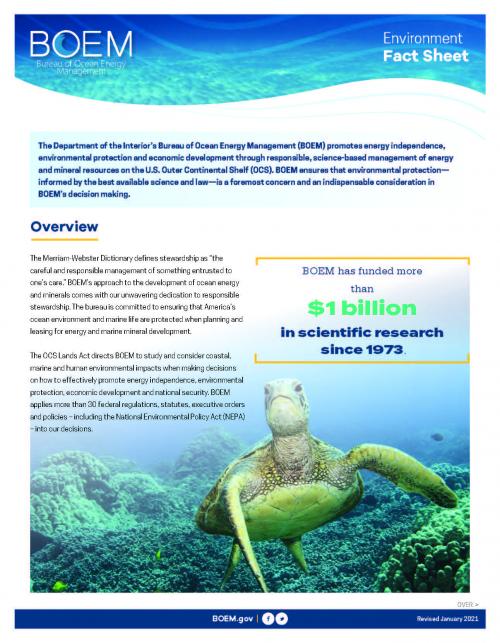
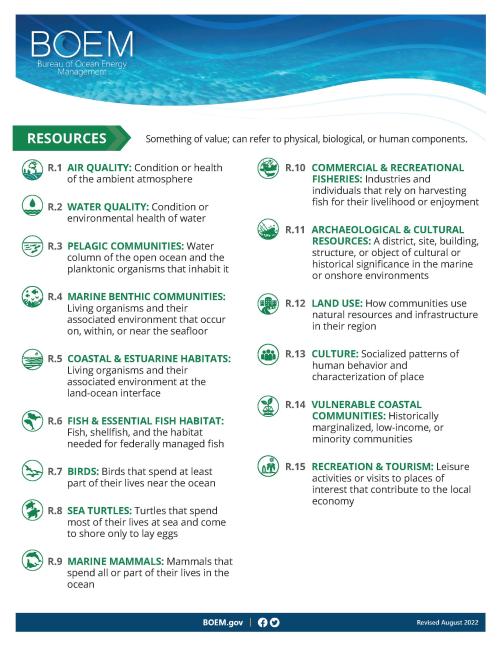

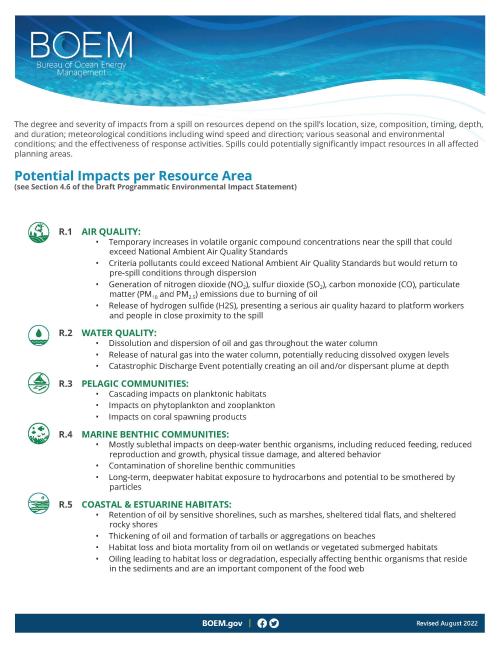

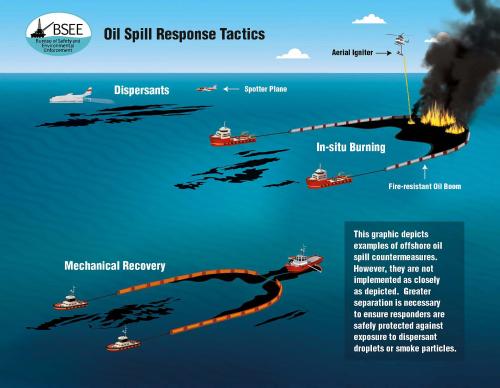
Outreach
The OCS Lands Act prescribes the major steps (See Program Development Tab) to develop a National OCS Program, including opportunities for public comment. In August and September of 2022, BOEM held four robust and interactive experience Virtual Open House Public Meetings. Participants were given the opportunity to visit several virtual stations to have open discussions with BOEM staff and to ask any questions or request additional information.
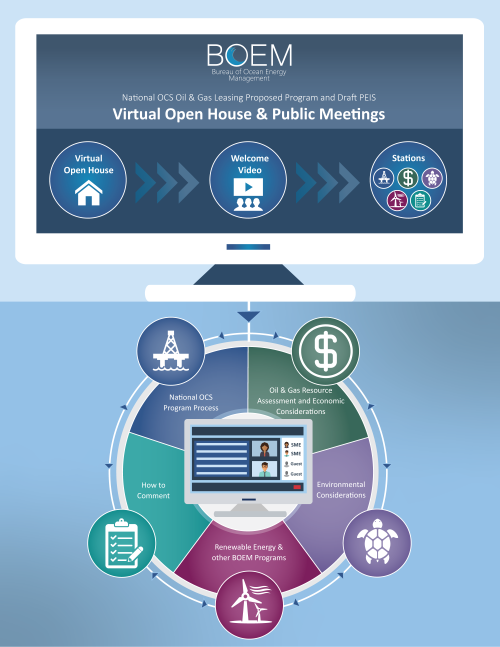
National OCS Program Development Cycles
| Cycle | Program years | Effective dates |
|---|---|---|
| 1 | 1980 - 1985 | June 1, 1980–May 31, 1985 (remanded October 6, 1981; replaced with 1982–1987 Program) |
| 2 | 1982 - 1987 | July 21, 1982–June 30, 1987 |
| 3 | 1987 - 1992 | July 1, 1987–June 30, 1992 |
| 4 | 1992 - 1997 | July 1, 1992–June 30, 1997 |
| 5 | 1997 - 2002 | July 1, 1997–June 30, 2002 |
| 6 | 2002 - 2007 | July 1, 2002–June 30, 2007 |
| 7 | 2007 - 2012 | July 1, 2007–June 30, 2012 (remanded April 17, 2009; revised 2007–2012 Program effective December 1, 2010) |
| 8 | 2012 - 2017 | August 27, 2012–August 26, 2017 |
| 9 | 2017 - 2022 | July 1, 2017–June 30, 2022 |
| 10 | 2024 - 2029 | July 1, 2024, – June 30, 2029 |


